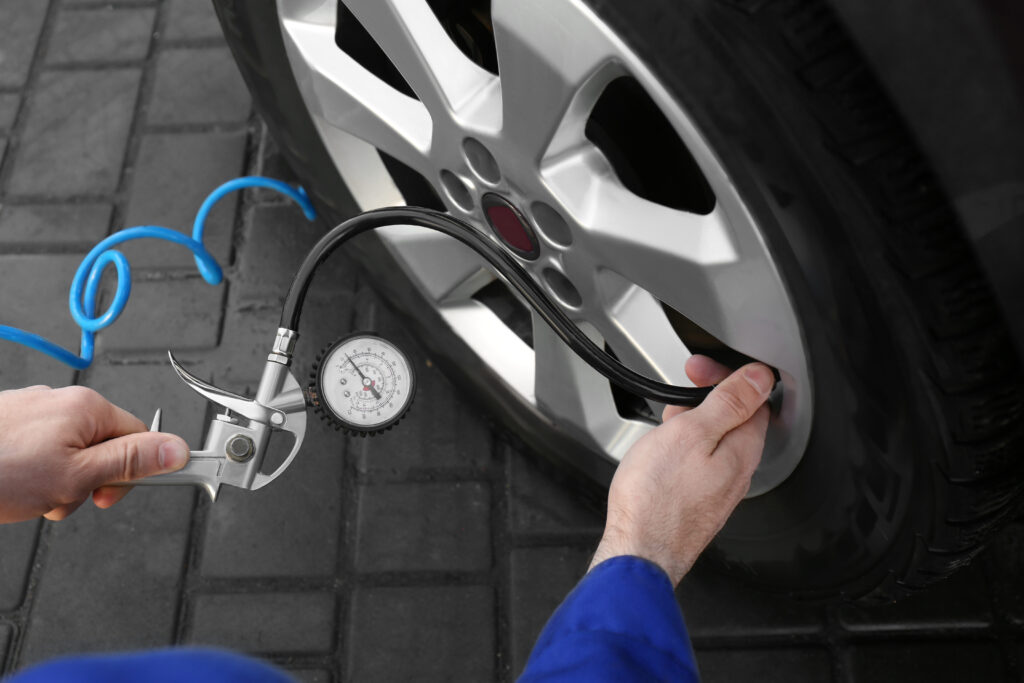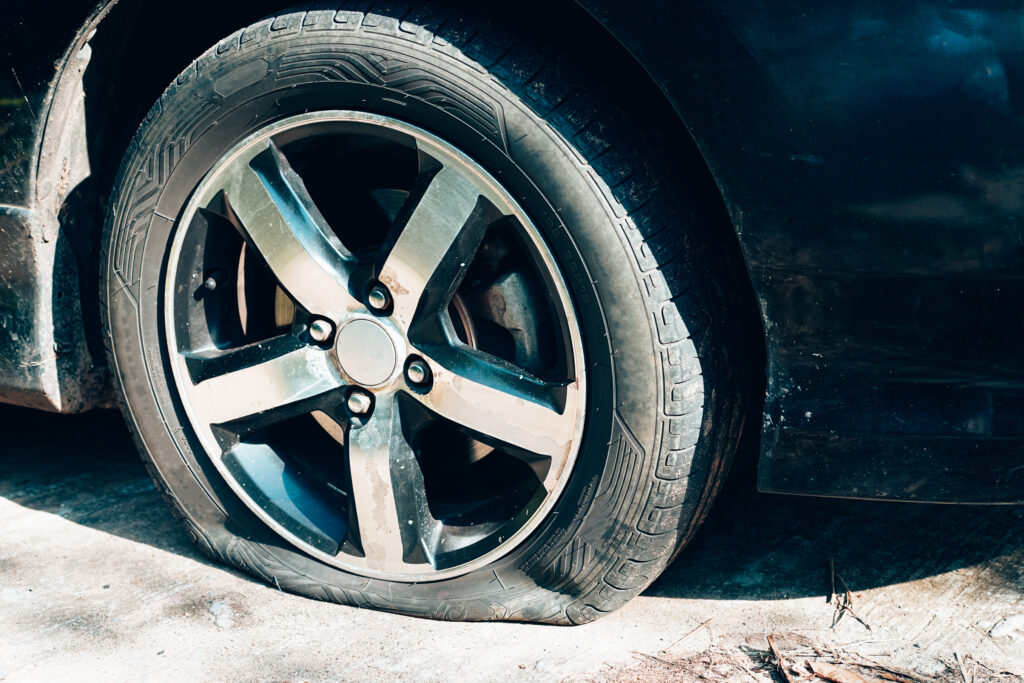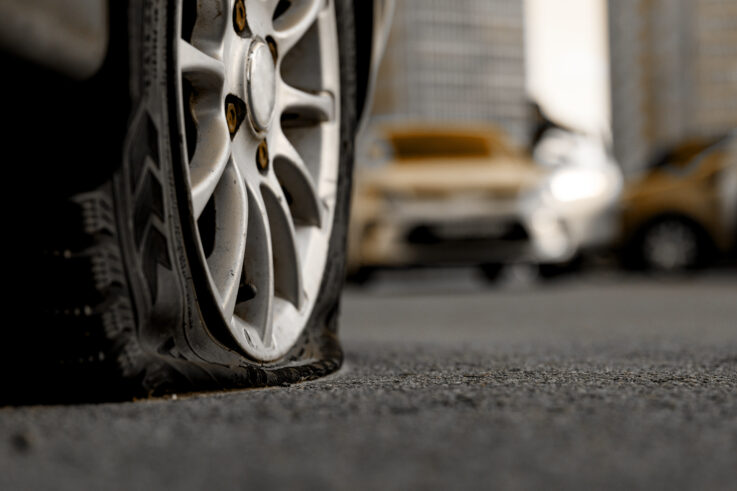When your schedule is already packed, the last thing you want is to keep stopping at the air pump. But letting this problem slide can lead to bigger headaches, like reduced fuel efficiency, accelerated tire wear and potential safety risks on the road.
In this blog, we’ll explore the most common causes of tire deflation and give you clear, actionable steps to diagnose and resolve the issue. By the end, you’ll know how to keep your tires in top shape and avoid unnecessary frustration.
Common Reasons for Tire Air Loss
Temperature Fluctuations
Have you ever noticed your tire pressure drop when the weather changes? Cooler temperatures cause air to contract, which can lower the pressure in your tires, while warmer weather has the opposite effect. These shifts are especially common during seasonal transitions and can leave your tires underinflated.
Permeation
Tire rubber is designed to be durable, but it’s also semi-permeable, meaning tiny amounts of air naturally escape over time. Even if your tires look perfectly fine, this gradual air loss adds up, especially if you’re not checking and maintaining proper tire pressure regularly.
Valve Stem Issues
The valve stem might seem like a small part of your tire, but it plays a big role in keeping air where it belongs. Over time, valve stems can crack, corrode or loosen, allowing air to escape slowly. Even the valve core inside the stem can develop leaks, especially if dirt or moisture gets inside.
That’s why checking the valve’s integrity should be a regular part of your tire maintenance routine. Replacing a worn or damaged valve stem is a quick fix that can save you the frustration of repeated air loss and keep your tires performing at their best.
Bead Leaks
The tire bead seals against the rim to keep air inside, but that seal can break down. When corrosion builds up on the rim or the tire isn’t seated properly, that seal can fail, allowing air to slowly escape. Even something as simple as hitting a pothole or curb can disrupt the connection, leading to a gradual loss of pressure.
Paying attention to the condition of your rims and ensuring the bead is seated correctly can prevent leaks. If you’re noticing repeated air loss without visible damage, the bead might be the culprit. Addressing it early can save you from ongoing frustration and keep your tires in working order.
Wheel Damage
Bent rims or corrosion on the bead seat can interfere with the airtight seal your tires rely on. Impacts from potholes, curbs or debris often cause these problems, leading to gradual air loss that can go unnoticed until your tire pressure drops significantly.
If your car has taken a hard hit, check your wheels for cracks, warping or rust. Resolving wheel damage not only helps stop air leaks but also keeps your tires seated securely for better overall performance.
Tire Punctures or Damage
It doesn’t take much — a nail, a piece of glass or other road debris can puncture your tire and start letting air out. These slow leaks often go unnoticed until your pressure drops enough to affect your driving. While punctures in the tread can usually be repaired, damage to the sidewall is a much bigger problem.
Sidewall damage weakens the tire’s structure and can’t be fixed safely. Scraping against curbs or hitting sharp objects often causes this type of damage, increasing the risk of a blowout if left unchecked. Be sure to inspect your tires regularly, and replace them if you see sidewall damage to avoid more serious issues down the road.
Why Proper Tire Pressure Matters

Here’s why keeping your tires properly inflated is so important:
- Vehicle Handling and Safety: Underinflated tires make steering less responsive and braking less effective, especially in emergency situations. This can increase stopping distances and reduce control, putting you at risk on the road.
- Fuel Efficiency and Environmental Impact: Low tire pressure forces your car to work harder, burning more fuel and releasing more emissions. Properly inflated tires help improve your car’s efficiency and reduce its environmental footprint.
- Tire Longevity and Resistance to Damage: Tires with the correct pressure wear evenly, helping them last longer and perform better. Over or underinflation leads to uneven wear, making your tires more prone to damage and costly replacements.
Always follow your manufacturer’s recommended tire pressure, typically found in your owner’s manual or on the driver’s side doorjamb. It’s a simple step that keeps your car performing at its best and helps you avoid unnecessary expenses.
Signs Your Tire Might Be Losing Air
Not all air leaks are obvious, but there are clear signs that indicate your tire might be losing pressure:
- Consistent Pressure Drops: If you frequently need to refill the same tire, there’s likely a slow leak causing the issue.
- Visible Damage: Nails, screws, cuts or bulges can all cause air loss. Bulges mean the tire’s structure is damaged, while nails and screws cause small leaks that can get worse. Cuts, especially on the sidewall, weaken the tire and make it unsafe to drive.
- Unusual Handling or Vibration: A leaking tire can affect your car’s balance, leading to vibrations or pulling to one side while driving.
- Overnight Deflation or Weather-Related Loss: A tire that’s noticeably lower in the morning or after temperature changes might have a weakened seal or structural problem.
If you spot any of these signs, it’s time to investigate further or consult a professional to prevent more serious problems.
Diagnosing the Problem
Figuring out where your tire is losing air doesn’t have to be complicated. Here are three simple methods to help you pinpoint the issue:
Soapy Water Test
Mix a solution with 1 part dish soap and 4 parts water. Spray or brush it onto the tire, focusing on the tread, sidewalls and valve stem. If you see bubbles forming, that’s where the air is leaking out.
Submerging the Tire
If possible, submerge the tire in a tub of water. Rotate it slowly and look for a stream of bubbles rising to the surface. This method works well for identifying even the smallest leaks.
Listening and Feeling for Leaks
In a quiet area, listen for a faint hissing sound that indicates air escaping from a hole. Run your hand along the tire’s surface, especially around potential trouble spots. If there’s a hole, you may feel a slight breeze or a cool spot where the air is leaking out.
How To Fix Air Loss Issues

Repair the Tire
For small punctures, a plug or sealant can provide a quick fix. However, sidewall damage or large punctures require professional attention.
Replace or Repair Valve Stems
Valve stems often go unnoticed, but they’re an easy fix. Replace them during tire installation to prevent future leaks.
Wheel Maintenance
Corrosion or bends in the rim can be repaired by a professional. If the damage is severe, a replacement may be necessary.
Inspecting and Fixing Bead Leaks
Sidewall damage, such as bulges or cracks, is often a sign of internal structural issues that compromise the tire’s safety. These problems usually require a full replacement rather than a repair.
Preventative Maintenance Tips
Taking a few simple steps can help you avoid unexpected tire issues and keep your vehicle running smoothly:
- Check Tire Pressure Regularly: A reliable gauge helps you monitor tire pressure accurately, ensuring it matches the recommended level.
- Inspect for Damage: Routinely check your tires for signs of trouble, like nails, screws or cuts in the tread. Pay extra attention to the sidewalls, as bulges or cracks often mean internal damage that isn’t safe to repair.
- Rotate Tires and Check Wheels: Regular rotation prevents uneven wear, and inspecting your wheels for corrosion or damage keeps the seal secure.
- Replace Tires and Valve Stems: Aging tires and worn valve stems are common sources of air loss. Replacing them before problems arise saves you time and money.
- Monitor Seasonal Changes: Cold weather can lower tire pressure, while heat causes it to rise. Keep an eye on your tires during temperature shifts to maintain proper inflation.
Watch for bulges or cracks along the sidewalls, as these usually point to internal damage that requires a tire replacement to ensure safety.
The Importance of Professional Inspections
Some tire issues require more than a DIY fix. If you’re dealing with persistent air loss and can’t find visible damage, or suspect bead or rim problems, it’s time to visit a technician. These kinds of issues often need specialized tools and expertise to repair properly.
Investing in a professional inspection ensures that nothing is missed. Technicians can identify hidden problems like internal damage or faulty valve stems that could lead to bigger, more expensive issues down the road. Regular inspections also help extend the life of your tires, improve your car’s safety and save you money in the long run by addressing problems before they escalate. It’s a small investment that pays off in performance, safety and peace of mind.
Don’t Let Tire Problems Slow You Down
Underinflated tires affect your safety, waste fuel and wear out faster. Whether it’s a slow leak, bead issue or hidden damage, Apex Automotive has you covered. Our expert technicians will inspect, repair and maintain your tires to keep you safe, save you money and improve your car’s performance.
Schedule your appointment today, and let us take care of your tires so you can focus on the road ahead.


